“There is nothing new under the sun, but there are new suns.” –Octavia Butler
“There is nothing new under the sun, but there are new suns.” –Octavia Butler

Our premise is the simple notion of curiosity and exploration through the lens of artistic practice. What insights might we gain from unlikely friendships, cross-pollination, proximity to unresolved issues, and the joy of following what strikes our fancy? This index compiles each contributor and issue for your perusal. What constellations will you map through this practice?
| Title | Issue | Listen |
|---|---|---|
 Finding Flow
Finding Flow
|
Issue 13 | |
|
The eleven contributors to the final issue of New Suns are all awardees of the Disability Futures Fellowship, a three cycle initiative that asked the question of “What comes next?” at the time of its creation six years ago. Now at its conclusion, having awarded sixty incredible Fellows, we are again, of course, at the crux of that question. So how do we as a community of creatives best attempt to answer it? The artists here offer a stewardship of the past to the present, and as you maneuver through the contributions you can find openings to paths of futures we need and want. Finding Flow, the title of the issue, suggests that we are doing just that — reflecting on the passage of time to find our way in, with, and through it to wherever it takes us next. To create a present and future memory, artists are tapping into ancestral and land-based knowledge, digging deeper into archives to tell stories that have not been told, blurring and stretching time in collaged sound through recordings, and reflecting on how we spend our time in creating, making, resting, and nourishing — alone and in community. As the Disability Futures Fellowship sunsets, we can grasp that the wisdom flowing through Disability Futures Fellows’ sharing will ripple out in our worlds, towards the feelings and futures we want to find ourselves in. Ezra Benus
JJJJJerome Ellis
2507 Finnegan Shannon Strategizing Alternatives Emily Sara Strategizing Alternatives Naomi Ortiz From Earth to Orbit: Excavating Time Eli Clare The Accordion of Time luz guerra The Accordion of Time Tourmaline The Accordion of Time Dickie Hearts Access as Aesthetic Christine Bruno Access as Aesthetic Natasha Ofili Access as Aesthetic Jen Deerinwater Disability Festivities |
||
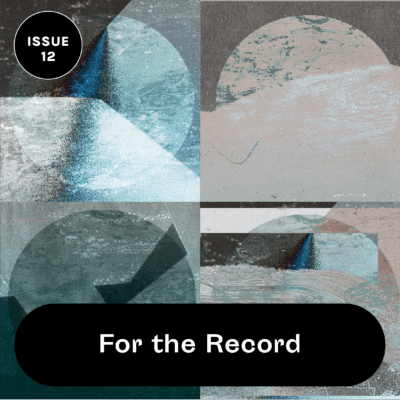 For the Record
For the Record
|
Issue 12 | |
|
In the arts, discussions around institutional archives abound. We know, though, that what’s on view at a museum is only a sliver of its holdings and that museums are not the only keepers of artifacts. With this in mind, we invited artists to deepen and expand our understanding of archives: how they’re made, who keeps them, and why they matter (or don’t). As sculptors, musicians, designers, and filmmakers, each contributor in For the Record brings their own sensibility to the contentious practice of archiving. They challenge us as individuals to archive with more intention, generosity, and openness than institutions can in order to undo and prevent continued erasure. Moreover, the issue title nods to New Suns’ own function as a dynamic archive of contemporary artists’ perspectives from different disciplines and regions. As we enter our fifth year of circulation, we remain committed to evolving this platform by, for, and about artists and the themes driving their work. And as always, we hope the ideas you encounter here expand your creative horizons. In orbit with you, |
||
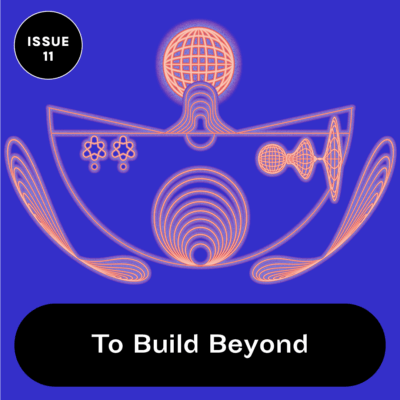 To Build Beyond
To Build Beyond
|
Issue 11 | |
|
In this issue, we invited artists to deepen and expand our understanding of worldbuilding: What materials and languages do they use in that endeavor and why? What world are they after and how are they trying to get there? Whether working in sound, animation, fashion design, literature, architecture, or ephemeral installation, each contributor in To Build Beyond constructs from a place of hope and aspiration. They see both the pain and potential of this present moment on Earth and offer moments of respite, repair, and release through their practices. From them we learn to embrace the local: our bodies, our geographies, our communities. From these sources of knowledge, we have the resources to sustain ourselves in the long run, if we only attune to them more readily. In orbit with you, Jessica Ferrer and Kate Blair |
||
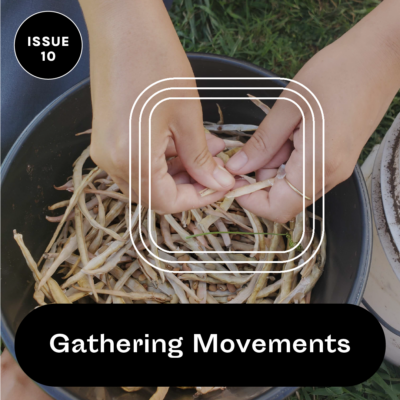 Gathering Movements
Gathering Movements
|
Issue 10 | |
|
Artistic labor tends to be undervalued and misunderstood. In many ways, artistic labor can look like any other profession, but a focus on art as a product leaves many moments within a practice unaccounted for: for instance, the untold hours developing a skill or acquiring and maintaining equipment; the hours spent dreaming, thinking, observing, and questioning. Artists are wonderful investigators into these smaller moments that make up a day’s work, and their analysis is key to understanding labor issues that affect all of us. Issue 10, Gathering Movements, explores artists’ connections to labor as thinkers, activists, and documenters. In this issue, we asked how artists can help us to better understand issues that impact all workers, but most of all, we ask, where is the labor in an artistic practice? What is appreciated as labor, and where do these definitions become murky? Artists thrive in those in-between spaces where dreaming and play become part of the work of creating a better world. All of the contributors, of course, are artists. Most balance their artmaking with additional labor as teachers, caregivers, sex workers, and organizers. In their unique ways, all help us to dream of a better, more abundant world with fluid boundaries between work, play, and artmaking. With gratitude, |
||
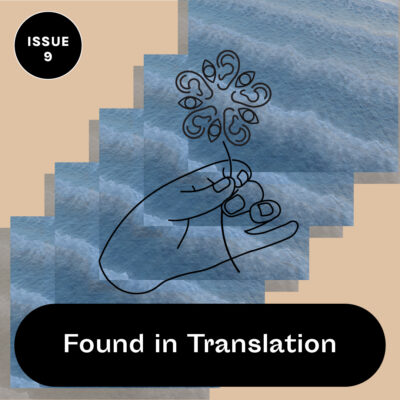 Found in Translation
Found in Translation
|
Issue 09 | |
|
How do artists encounter translation in their creative practices and daily lives? For this special edition of New Suns, we connected with twelve artists from Mutual Mentorship for Musicians (M³), an artist-led platform dedicated to empowering musicians from historically underrepresented identities and backgrounds, about how they transform ideas from their head and heart into outward sonic expressions. Their six paired conversations yielded tender revelations about the importance of trust, respect, and vulnerability between creative partners. We repeatedly heard that meaningful translation takes time and requires patience. It begins with showing up fully present, listening first, and then contributing. It also often means learning to let go of unsustainable practices and external pressures. In short, it means being willing to improvise. Rather than being bogged down by the way things are or have been, we admire these artists for their unwavering commitment to turning the tide toward care, of oneself and others. In spending time learning more about these musicians, we hope you feel encouraged to pursue your own forms of expression unapologetically. With gratitude,
Krissy Bergmark
Renewed Practice Naomi Geena Nakanishi Renewed Practice Tara Kannangara Drifting Together (Like Sea Lions) Rosángela Pérez Molero Drifting Together (Like Sea Lions) Aline Frazão On Flexibility Sattvitri On Flexibility Gwen Laster Permission to Daydream Kavita Shah Permission to Daydream Dafna Naphtali Growth Rings CC Sunchild Growth Rings Jessica Jones Trust Your Pace Zeynep Toraman Trust Your Pace |
||
 Piece by Piece
Piece by Piece
|
Issue 08 | |
|
How do artists use sampling to reflect on the past/present/future of artmaking? Sampling is a term with many artistic associations. Today, its most common definition refers to a process in music, where a melody or a beat isolated from another song becomes material for a brand new work. In fiber arts, however, sampling is both exercise and example — a way for the maker to both learn and then demonstrate what was learned. In many trades, sampling guides work on commissions and larger projects. Despite these various definitions, we found a few common themes: Sampling is a constant dialogue between new and old, between process and outcome. Sampling fuels and moves us through our interactions in art and in the world, honoring the past and the multiplicity of people whose work have made a craft or artform what it is today. As such, sampling can bring up ethical questions about ownership amidst the natural evolution of artistic methods. But even while sampling in all its forms involves a discussion of labor, we also learned the value of leading with intuition in the making process. Sampling, after all, is fundamentally about experimentation and play, drawing first and foremost from the raw material of life itself. Enclosed is a sampling of reflections on this topic, with contributions including artists working in sound, artificial intelligence, fiber and paper arts, publishing, and printmaking. We hope these pieces come together to create something bold and new! Yours in play, |
||
 How We Hold
How We Hold
|
Issue 07 | |
|
The thematic question for this issue of New Suns surfaced in the last issue, Ways of Learning. As contributors emphasized the importance of archives in their practices, we were compelled to ask: How do artists approach vessels and containers, both in terms of utilitarian object and metaphor? We were also inspired by Ursula K. Le Guin’s “Carrier Bag Theory of Fiction,” in which she positions the carrier (basket, net, pouch) as more compelling and more necessary than any weapon (spear, stick, arrow) or hero wielding it. This latest issue of New Suns examines how five artists hold and carry their memories and dreams through wood, fruit, feathers, and glass. We’ve learned that these materials possess their own histories and desires that the artists respect, admire, and uplift through their work. As you spend time with each of them, we hope you feel a renewed sense of what it means to gather and collect. With gratitude, |
||
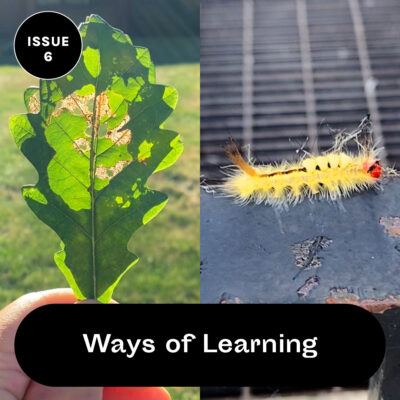 Ways of Learning
Ways of Learning
|
Issue 06 | |
|
At its best, teaching is a humanistic project that has the power to help us build strong communities. However, mainstream systems of education not only discourage the joyful exploration that comes naturally to learners, but uphold the status quo, reproducing inequities. For this issue, we wanted to explore teaching and educational practices, to probe at what’s necessary in an education, how to meet the needs of students of all backgrounds, and what skills are crucial to cultivate. In the beginning, we wondered how artmaking itself, as a unique mode of inquiry, could be a useful model for pedagogy. In retrospect, we discovered that wasn’t quite the correct framing. In listening to the generous perspectives of our contributors, we leaned into being students and shifted our ideas: accepting imperfection and focusing on the process of inquiry over the outcome. For that reason, we felt it was fitting for this issue to unfold through a series of exploratory conversations. We sought out artists who place emphasis on the intellectual work and artistry of teaching itself and who have made it a mission to subvert the current system. How can we center justice, wonder, and possibility in education? The conversations that make up the issue reveal how expansive the topic of education can be, from creating intentional spaces where the work of education can take place to following where a mistake can lead, sitting with ugly realities, and teaching people to think in ways that will help us build a better world. We also came to understand how much of learning begins with building archives, even if the processes and histories being documented are messy or unfinished and the archive itself is untraditional. We were thrilled to continue this practice by documenting these nine brilliant artists, makers, and community builders in conversation. Through them we witnessed the kernels of new ideas spark into being, offering starting points for a different kind of education that centers justice, wonder, and possibility. With that spirit in mind, we have collected discussion questions based on the interviews, which you can find below. We hope you will continue to explore with us! In process, |
||
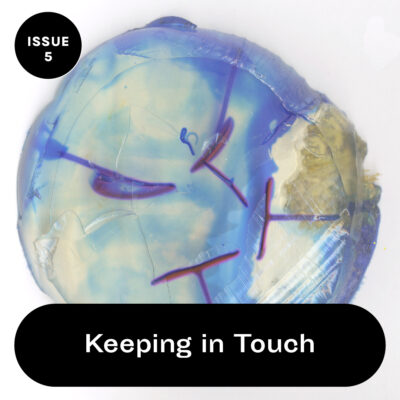 Keeping in Touch
Keeping in Touch
|
Issue 05 | |
|
In recalling that the second issue, Seeding Care, centered around formations of kinship, this issue foregrounds the role that touch plays in sustaining connections to ourselves, each other, and the present moment. We invited contributors to reflect on their approach to physically and metaphorically “feeling” something out, and asked them: How do artists use touch, tactility, and tacit knowledge in their practices? Their responses vary, but each person identifies the importance of interfacing with a material, audience, or environment; of listening with one’s hands or whole body. These artists appreciate the sensing capacity of our skin and how the information it gathers plays a major role in the way we navigate both private life and public spaces. They recognize that our current conditions remain unsafe for the kinds of platonic touch humans tend to crave, and have instead created new ways to connect with themselves and their communities. And maybe most importantly, they argue that a touching approach is a fully-feeling approach, an approach that’s especially useful in bringing our racing minds to a gentle (or abrupt!) halt to insist on the now and not-yet-known. In spending time with these artists’ musings, we hope you are reminded of the value of both feeling and feelings as you move through time. Waving, Editors |
||
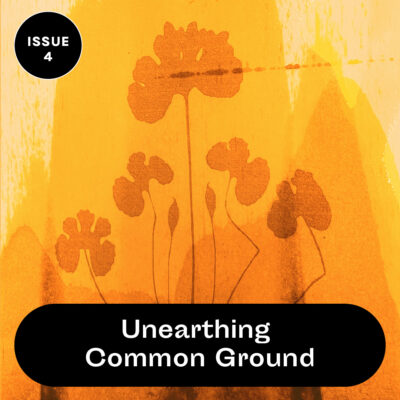 Unearthing
Unearthing Common Ground |
Issue 04 | |
|
With our first issue, Mapping the Horizon, we asked artists to look forward, upwards, and outwards into an imagined future. With this issue, we changed our perspective to look down, around, and in. Curious about how artists and makers can guide us to be thoughtful about our surroundings, we asked: How do artists help us re-envision our relationship to land and nature?” Issue 4 is an inquiry into place, a sort of field recording, guided by artists working in diverse mediums and approaches. They examine relationships and trouble the binaries between humans and their environment, taking into account the histories of movement and displacement that brought them to where they are now, into new communities of flora and fauna. They recognize that the ground beneath our feet has witnessed extraction of goods, cultivation of industrial crops, displacement of humans and other organisms, and the reinforcement of borders through Western cultural imperialism. But there is also beauty, calm, and bounty we can call upon in moments of strife, and knowledge of nature that allows us to sculpt better environments for human life. We found that looking around naturally leads to inward contemplation, bringing themes of identity and community to the foreground, and when ruminating on the specificity of a place, evocative relationships emerge. The story of the land is not just outside, but reflects internal realities: what’s inside and outside are mutually reinforcing. Issue 4, Unearthing Common Ground, represents an ongoing inquiry into the ways people and the land need one another, and how their unique histories must be taken into account for mutual healing. In symbiosis, Kate Blair and Jessica Ferrer |
||
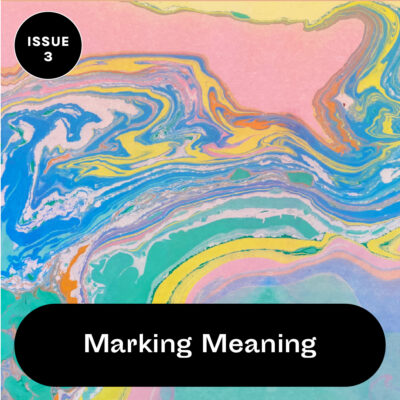 Marking Meaning
Marking Meaning
|
Issue 03 | |
|
This issue is a note on notation, those systems of symbols we employ as abbreviations for bigger and longer ideas, i.e. sheet music, algebra, HTML. When enough people agree about a particular kind of notation, it makes sharing information faster and easier. It also, however, codifies a way of doing something that unwittingly creates cognitive bias, a taking-for-granted that renders change inconvenient, if not unnecessary, because things seem fine as they are. Yielding to the pre-existing makes us nervous; we worry about the exclusion and esotericism that occurs alongside our desire to exchange ideas conveniently. And so, in this issue, we’ve turned to six multi-hyphenate artists for insight into how we might resist notational bias, and ask: What does notation do? These artists celebrate notation as a vehicle for elaboration, correction, translation, and invention in their work. They nudge us out of our comfort zones, unsettling expectations for what a given mark might mean, and equip us with new shorthands for beauty, access, and belonging. They are unafraid to leave room for interpretation and inhabit spaces that are fluid and in-between. More than anything, in spending time with these artists and their ideas, it becomes clear that succumbing to existing notational systems is a creative dead-end, a sure way to halt worthwhile discovery. To stay open, in other words, is to stay possible. With great care, Jessica Ferrer and Kate Blair |
||
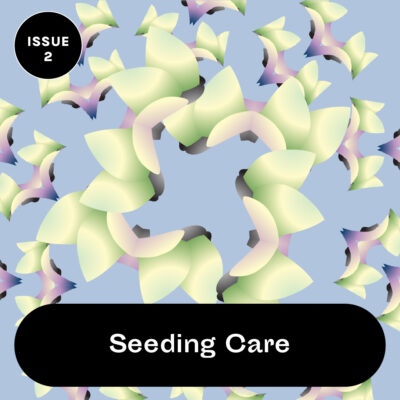 Seeding Care
Seeding Care
|
Issue 02 | |
|
What comes to mind when you consider kinship? The immediate associations are belonging, love, commonality. But there’s another aspect of this definition, too. At least the way we conceive of it in the United States, kinship can be a loaded term, which uses lineage as a way to transfer property, names, and power, or alternatively, to deny these things. Our current environment seems designed to only foreground the ways of belonging to one another that support the systems already in place, which too often leave our loved ones on opposite sides of borders, both invisible and visible, creating an inside and an outside. To help us think through these tangled definitions for Issue 2, we asked: How can artists help us better conceive of kinship (or reconceive it) by exploring paradigms of care, old and new? With their attention to process and material and embodiment, the artists showcased provide useful ways to interrogate how care and kinship intersect. What comes out of these responses is an acknowledgement of the messy but profound connections all humans have to one another, to the land we live on, and the many strategies artists have for awakening or revisiting these connections. We can look to natural metaphors as a means to guide our care for the humans in our lives or become attuned to the body’s existence in space as a means of understanding the power dynamics at play within and around us. We can turn to materials to consider the ways human lives are stitched together, or even the material of language itself as a tool that bridges space and time. All of these responses are another way of asking, again, what is kinship, and who are kin? What work must we do to earn the honor of being kin to one another? With gratitude, Kate Blair and Jessica Ferrer |
||
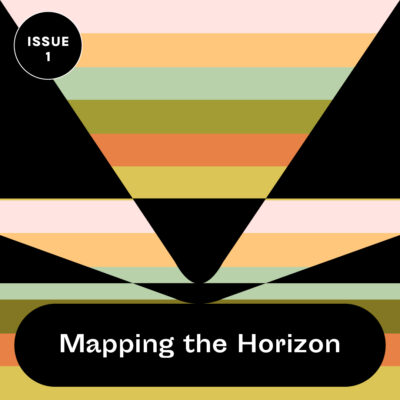 Mapping the Horizon
Mapping the Horizon
|
Issue 01 | |
|
Welcome to New Suns: Listening with Artists, where we connect with artists to learn from their experiences, ask them outlandish questions, and receive responses we don’t always expect. Here you will encounter, among other things, scintillating pixels, burbling ponds, and sentient blobs. What you will not find are cut-and-dry solutions, or grand claims about art’s ability to fix all of the problems facing society today. That is the work of everyone. We hope that each commission, though, illuminates the importance of process, play, and practice as we move through the world. This inaugural issue is called Mapping the Horizon and features six artists’ explorations of horizons future, interior, and present. Commonly thought of as the place where sky meets earth, the horizon is also an unreachable place, a space of potential that begets endless journeying. The challenge of charting or depicting horizons inspired the question we asked contributors to consider this time around: What does the future hold and what role do artists play in shaping it? In launching this publication, we had hoped to facilitate a space of flexibility and reciprocity with artists to encourage moving at a slower and smaller pace than we often feel accustomed to. For some, the process kickstarted a new body of work or enabled experimentation. For others, it offered space for reflection on how they approach making. And as for us, we’re still pinching ourselves over the good fortune of being in conversation with such generous minds. It is our hope you feel the same after spending time with them, too. With wonder, Jessica Ferrer and Kate Blair |
||
